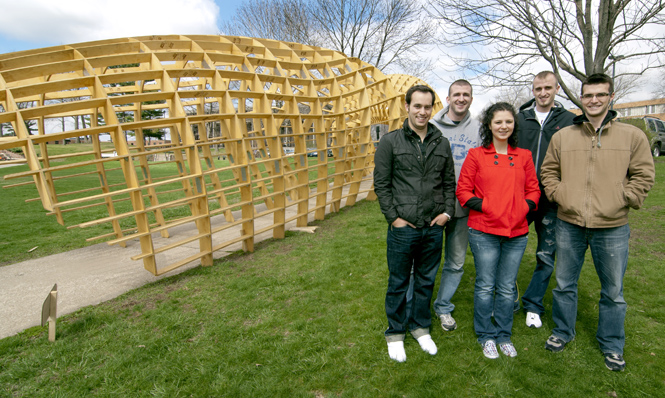Wooden tunnel-like structure opens near Taylor Hall
Brian Thoma, Carl Veith, Victoria Capranica, Matt Veith and Griffin Morris, all architecture graduate students, stand next to “The Passage” which they all worked to create. The structure is located outside Taylor Hall and will be removed before May 4th. Photo by Matt Hafley.
April 21, 2011
By Taylor Hall, there are paths, twists, curves and now a new dimension.
“I’m proud of the design we’ve accomplished,” said assistant professor Bill Lucak. “Now we’re moving on to more designs and structures.”
Near Taylor Hall is a new tunnel-like structure called The Passage. No drawing boards or rulers were used for what Lucak and his students have designed. Instead, he and two graduate students created the wooden structure on a computer. Lucak said this technique is proof of what the future of architecture holds at Kent State and all around the globe.
Victoria Capranica, senior architecture studies major, is one of the two students who took part in creating the design for The Passage. She said they used a 3-D software system called Rhinoceros to create a blueprint on what their design would look like.
“We played around with Rhino to see what we can make and see how things fit together,” Capranica said. “The design just kind of morphed into what it is and started out small and turned to what it is you see outside.”
Last semester, Capranica, Lucak and Griffin Morris, a graduate student in architecture, entered their design in the Matrix Design Competition, a Kent State architecture contest that judges which design is best in show. Their design stood out so much the architecture department wanted to put it on display.
“We all pitched in some money to put it up by Taylor Hall,” Morris said. “All and all, I’m very happy with the outcome of where our designs led us.”
Douglas Steidl, dean at the College of Architecture and Environmental Design, said the department granted about $2,000 for the structure to be built.
“I strongly believe this design is a physical manifestation of the creative thought process, implemented through digital fabrication techniques,” Steidl said. “Consequently, this application demonstrates the ability of the College of Architecture and Environmental Design at Kent State University to teach and execute in the context of current and future design/construction parameters.”
After receiving the grant, Lucak said he, Morris, Capranica and several other students helped build the structure with their own tools and no construction company.
“The pieces on The Passage literally go together like puzzle pieces,” Lucak said. “It was hard labor, and finding a location to put it was also a bit difficult, but we came through.”
In choosing a location, Morris and Capranica said they wanted to move the structure away from the May 4 Memorial site.
“It was a sensitive dilemma to find an appropriate location,” Morris said. “But it wasn’t very long until we found a good spot.”
The structure is only temporary because of its potential liabilities. Lucak said the structure poses a safety risk that the university does not want to be responsible for.
“It’s made of wood,” “Lucak said. “Yeah it could last for some time, but it can’t stand forever. Plus, it only takes one student to get hurt, and I would not want to be responsible for that.”
Morris said there is a sign by The Passage stating no one should climb the structure because pulling or stepping on certain parts of the ribs, as they’re called, could cause them to break.
“It would be cool to see this be a permanent structure,” Morris said. “But even though the wood is marine-grade wood, it would have to be stained and painted every year to keep it lasting. Plus, I’m pretty sure people aren’t going to follow the ‘no climbing’ sign.”
Though the structure will be taken down in two weeks, Lucak, Morris and Capranica said they are happy with what they’ve accomplished, as are the other students who helped build it.
“We now live in an age where computers are helping us improve our society.” Lucak said. “It would’ve been almost impossible designing this structure with a pencil, and I can’t wait to see what we can build next time around.”
Contact Seth Cohen at [email protected].

























